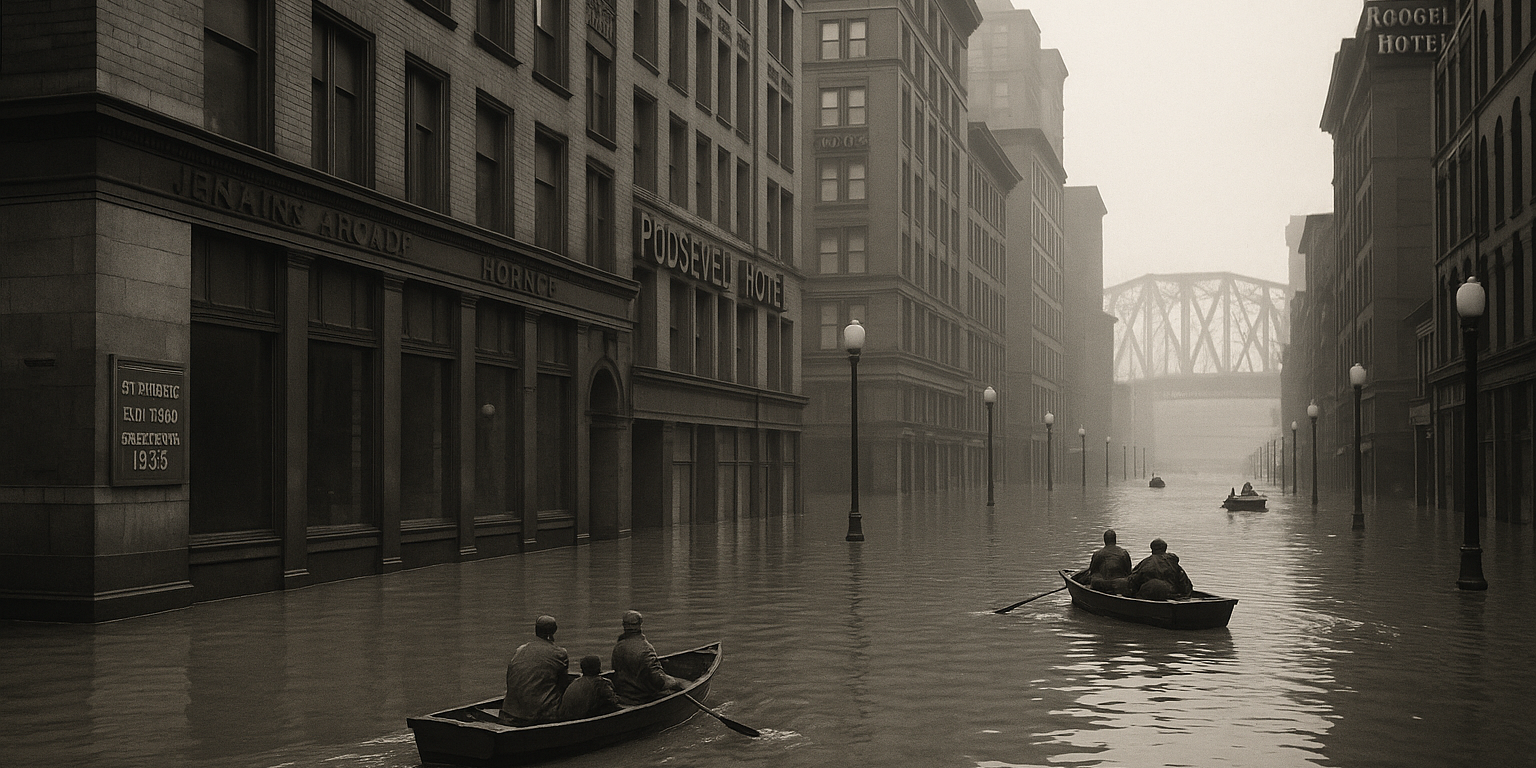Pittsburgh has always been a river town. The Allegheny, the Monongahela, and the Ohio aren’t just pretty landmarks or navigational quirks — they shaped everything about the city, from its steel empire to its street grid. But as any seasoned Yinzer will tell you, those rivers aren’t always friendly. Sometimes, they rise up and remind us who’s really in charge. And no reminder was louder or more devastating than what happened in March 1936: the Great Flood that swallowed the city whole and left a legacy still felt today.
A Winter That Refused to Quit
The lead-up to the disaster started quietly. Winter in 1936 had been especially cruel. Snowstorm after snowstorm pounded Western Pennsylvania. The Allegheny Plateau, the valleys, and the hillsides were buried in record snow. But the deep freeze didn’t let up. That meant all that snow just sat there, waiting. The ground underneath either froze solid or turned to sponge. Come March, a warm front blew in like a switch had been flipped. Temperatures soared. Ice broke. Snow melted fast. Water poured off the hills like someone had yanked the drain plug from a bathtub.
Then, just as Pittsburgh’s rivers and creeks were starting to get twitchy, Mother Nature upped the ante. On March 15th and 16th, the skies opened. Torrential rain fell for 48 hours straight. It soaked everything. The rivers, already heavy with meltwater, began to swell. By the time residents turned in for the night on the 16th, the rivers had grown mean. And still, local forecasts said little more than “more rain and colder weather.”
March 17th: No Luck on St. Paddy’s Day
St. Patrick’s Day morning, 1936. Instead of bagpipes and green beer, Pittsburghers woke up to water creeping into their streets. The Allegheny, Monongahela, and Ohio had breached their banks, and they weren’t done. Fast-rising currents tore through neighborhoods with ferocity. By mid-morning, water levels had passed 36 feet — 12 feet over flood stage. And they kept climbing.
Down at the Point, where the three rivers meet, water surged with a force not seen in living memory. By the evening of March 18th, the Ohio River had crested at 46 feet, beating the 1907 flood record by more than 7 feet. Barges broke loose. Docks crumbled. The current was so strong it pulled buildings from foundations.
The worst part? River traffic on the Ohio had already been stalled for 40 days before the flood even started, due to ice and high water. The rivers were already under strain. The system cracked.
The Golden Triangle Becomes a Murky Lagoon
Downtown Pittsburgh, usually buzzing with commerce, turned into a watery maze. Businesses from the Point to Grant Street found themselves submerged. Sixty-five percent of the business district was under water. Streets like Liberty and Penn were completely impassable. Rowboats floated where trolley cars used to run. People navigated by canoe past once-thriving storefronts.
Jenkins Arcade, Horne’s Department Store, the Roosevelt Hotel — all saw water lapping against second-story windows. Wood Street was a canal. The Strip District, with its wholesale produce markets and warehouses, became a soggy ruin. Refrigerated goods floated down the street. Machinery rusted in place.
And infrastructure? Completely overwhelmed. Power plants failed. Tens of thousands lost electricity. Heating systems went down, and Pittsburghers faced March temperatures with no heat. To make matters worse, gas lines cracked and leaked. Fires broke out in places firefighters couldn’t reach. It was chaos. The water wasn’t just wet; it was toxic, unstable, and dangerous.
Banks and Stock Brokers in Waders
Pittsburgh’s financial institutions didn’t fare much better. The Pittsburgh Stock Exchange had to halt operations. Fourth Avenue, the city’s financial heart, was underwater. Banks scrambled to preserve assets. Clerks worked by candlelight, moving ledgers and files to higher floors. First National, Farmers National Deposit, and People’s-Pittsburgh Trust Company all shut down temporarily.
Even the mighty bank vaults couldn’t stand up to the flood. Water seeped into safe deposit boxes. Concrete walls meant to be impenetrable gave way to the relentless surge. But despite the mess, many banks found ways to keep serving customers, a point of pride for a city that doesn’t give up easy.
The Flood Spares No Neighborhood
While Downtown took center stage, Pittsburgh’s neighborhoods were getting slammed too. The South Side saw entire streets go under. Lawrenceville suffered fires sparked by flooding at the Waverly Oil Works. Millvale was nearly wiped out — old footage shows buildings half-swallowed by the Allegheny.
Oakmont? Rough. Over 130 buildings flooded, many with water up to the roof. Residents clung to porches, waiting for boats to come. McKeesport had 600 evacuees, especially in the First Ward where the Yough meets the Mon. The city’s water supply gave out. Public services crumbled. For days, McKeesport functioned like it was the 1800s again.
Even upriver in Braeburn, the flood turned deadly. Lock and Dam No. 8 failed. The wingwall collapsed, and water rushed through like a freight train. It washed through homes and storefronts. Twelve feet of water crept up the walls of the train station.
Ordinary People, Extraordinary Acts
Despite the horror, Pittsburghers didn’t sit around waiting for help. Neighbors helped neighbors. Folks linked arms to cross rushing streets. People used doors, barrels, and wooden boards as makeshift rafts to rescue the stranded.
KDKA Radio, still broadcasting from its Saxonburg station, became a vital link. News updates. Safety bulletins. Emotional support. If you had a battery-powered radio, you had a lifeline. But with power out almost everywhere, many Pittsburghers were flying blind.
The American Red Cross jumped into action, opening more than 150 shelters. In Pittsburgh alone, 60,000 displaced people got food, warmth, and dry clothes. Volunteers came from all over. Louis Armstrong, touring nearby, held benefit concerts. Donations poured in.
President Roosevelt got involved. He ordered the WPA and CCC to send workers to Western Pennsylvania. They cleared wreckage, built temporary shelters, and handed out supplies. Federal aid arrived quickly, a rare thing in that era.
Faces and Memories from the Mud
Talk to flood survivors, and you’ll hear a mix of awe and heartbreak. A photo taken just before the flood showed people ice skating on the frozen Ohio. Days later, that same river was a raging brown monster. Tarentum families lost homes and businesses they’d built over generations. Brackenridge residents remembered climbing out second-story windows into rescue boats.
In Johnstown — no stranger to floods — residents watched the rivers rise with the same dread they’d felt in 1889. The whole region held its breath.
The Human and Economic Toll
The numbers still sting. At least 69 people died in Pittsburgh. More than 150 across the region. Over 500 injured. 100,000 left without homes. Half of them took shelter in schools, libraries, or hastily built camps.
And the economy? Brutalized. Steel mills along the rivers were knocked out. 60,000 steelworkers idled overnight. Trains stalled. Shipments halted. Stores shuttered. Pittsburgh’s engines went silent just when the country needed industry the most.
What Comes After: Blame, Rumors, and Reform
As the water receded, rumors filled the vacuum. One story had the 16th Street Bridge collapsing. It hadn’t. But fear was enough for the city to close every major bridge until inspections were completed. Misinformation spread quickly when phone lines and newspapers were crippled.
Finger-pointing began. Why weren’t the rivers better managed? Why did the flood warnings come so late? Civic groups had been begging for flood control dams for years. Now, finally, Washington listened.
In June 1936, just months after the flood, Congress passed the Flood Control Act. It funded a system of reservoirs and dams across the Allegheny watershed. The U.S. Army Corps of Engineers got to work. Over the next two decades, Pittsburgh saw levees reinforced, locks improved, and backup systems put in place. The city wouldn’t be caught unprepared again.
Mayor Cornelius Scully and other local leaders pushed hard for recovery. City Council demanded a coordinated rebuilding plan. Business leaders met in emergency sessions. What followed was a full-scale civic mobilization.
Lasting Impact and Ongoing Memory
The St. Patrick’s Day Flood reshaped Pittsburgh. You can still see its shadow in high-water markers on buildings like the Post-Gazette. Walk past Grant Street, and you might spot a faint line etched into a stone wall — a quiet warning from the past.
New developments near the Point were built with flood risk in mind. When Point State Park was expanded, planners used it as both civic space and a water buffer. The city kept growing, but it never forgot the lessons from March 1936.
Today, public art honors the victims. Painted stones. Plaques. Murals. The name “The Great Flood” still carries weight around here. It wasn’t just about water. It was about resilience, ingenuity, and community in the face of disaster.
Conclusion
The St. Patrick’s Day Flood of 1936 wasn’t just a weather event. It was a moment that cracked open the soul of Pittsburgh, showed its vulnerabilities, and also revealed its heart. A city known for grit proved it in spades. Neighbors didn’t wait for help. They became the help.
That flood changed how Pittsburghers thought about their rivers. It spurred reforms, inspired solidarity, and reminded everyone that even in the darkest hour, this city doesn’t go under without a fight.









